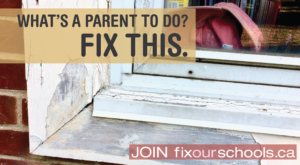The fact is that, for over two decades in Ontario, our provincial government has held control over all the money that is allocated to schools via local school boards. Another notable fact is that, for most of this time, the provincial funding for school renewal and repairs (the money that enables a school board to conduct yearly maintenance and repairs on all of its school buildings) has been a fraction of what industry standards suggest is required.
In fact, early in our campaign, back in January 2016, we wrote a blog asking the questions, “What if you sent your child the store with $10.00 to buy a week’s worth of groceries for your family of four, and they came back, having failed to source sufficient groceries for the family for the coming week? Would you publicly shame them for this failure? “
Our suspicion is that the answer was, and would continue to be, NO! Instead, as the parent in charge of the household budget, you would take responsibility for the fact that, with the money you gave them, they couldn’t possibly have succeeded in buying a week’s worth of groceries for a family of four. Are we right?
And yet, for decades, Ontario’s Ministry of Education and our Premier have frequently blamed school boards for the accumulation of billions of dollars of disrepair in their school buildings while, at the same time, providing grossly inadequate funding (in many years, one-tenth of what industry standards suggest is needed!) to those same school boards.
The Provincial Governments for the last 2 decades have deferred their responsibility for the children of #Ontario. Shame.
They've allowed maintenance to accumulate to such a degree that kids now breathe in flaking paint, drink water w/ lead & sit in classrooms with EXTREME temps. https://t.co/X0utbfqPq9— Fix Our Schools (@Fix_Our_Schools) February 25, 2018
The dysfunctional dynamic of our provincial government pushing responsibility for successful outcomes on to school boards, while it retains all the power over the money, continues today, amidst a global pandemic. Fix Our Schools expressed outrage and anger several weeks ago when Premier Ford said, Premier Ford said, “We’re really relying on school boards. I just told them I have all the confidence in the world that they’re going to be able to get through this and make sure that the students and the staff are in a very safe environment”.
This type of rhetoric is disingenuous, at best. It is also dangerous, unfair, and prevents solution-oriented dialogue from occurring. Our current Minister of Education, Stephen Lecce has been vague about his government’s response, should a COVID-outbreak occur in Ontario’s schools.
Education minister vague when he says "if a challenge arises, we will be decisive." Parents want him to be decisive NOW:
📏📏 Fund 2 metre distancing
💨💨 FULLY fund ventilation systems upgrades#onted #onpoli #topoli @fordnation @Sflecce https://t.co/cWzG6a0TCM— Fix Our Schools (@Fix_Our_Schools) September 5, 2020
This type of response seems typical of the Ford government, which has flip-flopped on many issues since taking office over two years ago. However, amidst a global pandemic, citizens need a government that will take responsibility, and leads us forward in a positive manner. We do not need a government that behaves immaturely, and blames other entities, such as school boards, for its own mistakes.
Clearly, many issues are on our minds as Ontario’s students head back to school. For Fix Our Schools, ventilation and HVAC in our schools continues to be top of mind. We continue to wonder why the Ford government took two months to allocate funding for school boards to pursue work to ensure optimum ventilation for when school buildings re-opened after having been shuttered back in March. We continue to wonder why the Ford government only allocated such a small amount of money to school improvements amidst a pandemic, knowing that there are $16.3-B of disrepair in Ontario’s school buildings.
Canada’s schools need better air ventilation. Amid coronavirus, it could save lives https://t.co/Yr1iVWaSeb pic.twitter.com/FHRz5vmK0x
— Global National (@GlobalNational) September 13, 2020
A Global News article published on September 13, 2020, entitled, “Canada’s schools need better air ventilation. Amid coronavirus, it could save lives“ Fix Our Schools is quoted several times:
- “While the Ontario government has allocated $50 million in funding to improve HVAC systems in schools, it came only two months before classes were due to begin. It also came long after SickKids’ report cited ventilation as an important element in a safe reopening.”
- “You’ve got medical professionals telling you ventilation is key. You know that the 5,000 school buildings in your province have a gross amount of disrepair, and yet the province waited two months to announce a pittance in funding. On a per-school basis in Ontario, it’s $10,000 a school. It’s nothing. Truly, it’s nothing.”
- “School boards have been put in an untenable position. They’re beholden to the tender process, which takes time. And, because they’re chronically underfunded, they tend to feel pressured to choose the lowest-cost option, which should not be the criteria for all projects.”
In the same article, Jeffrey Siegel, a professor of civil engineering at the University of Toronto, agrees with the sentiments expressed by Fix Our Schools, and says that “the funding allocated so far for HVAC improvements “doesn’t even pass the laugh test”. The fundamental issue is that this is expensive to do under any circumstances, schools can be particularly so.”
So Premier Ford and Minister Lecce, the people of Ontario are actually relying on you and your government to make Ontario’s schools safe, healthy, well-maintained buildings that provide environments conducive to learning and working – not only amidst this pandemic but for always.



